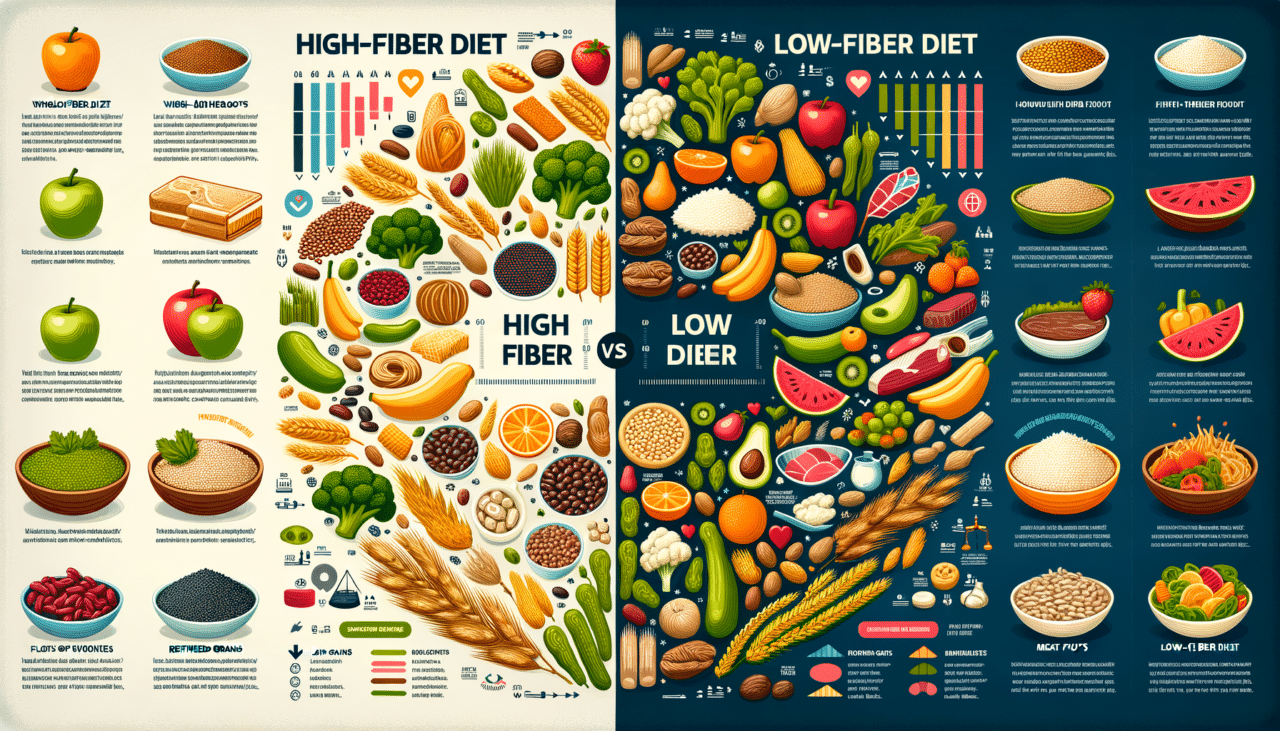Hello there, fellow health enthusiasts! Darrin here, ready to dive into a dietary showdown that’s been creating quite the buzz in the nutritional world—High-Fiber Diet versus Low-Fiber Diet. Now, before we get into the nitty-gritty, let me paint you a picture. Imagine a day in the life of your digestive system. It’s like a busy Australian highway—sometimes smooth, sometimes congested. What you put into your body can be the difference between a traffic jam and a free-flowing expressway. So, let’s explore which dietary road map might be the best fit for you.
The Basics: High-Fiber Diet
Characteristics:
-
Rich in Plant-Based Foods: A high-fiber diet is abundant in fruits, vegetables, whole grains, and legumes. Think of it as nature’s broom sweeping your digestive tract clean.
-
Types of Fiber: There are two types of dietary fiber—soluble and insoluble. Soluble fiber, found in oats and apples, dissolves in water to form a gel-like substance, while insoluble fiber, found in nuts and whole wheat, adds bulk to stool.
-
Daily Intake: For the average Australian adult, about 25-30 grams of fiber per day is recommended. That’s roughly the equivalent of munching through an entire forest of broccoli! (Okay, not really, but you get the idea.)
-
Health Benefits: High-fiber diets are like the unsung heroes of nutrition. They help maintain a healthy weight, lower cholesterol levels, and regulate blood sugar. Plus, they keep things moving smoothly, if you catch my drift.
The Basics: Low-Fiber Diet
Characteristics:
-
Easily Digestible: A low-fiber diet consists of foods that are gentle on the stomach and easy to digest, such as white bread, tender meats, and dairy products. It’s like giving your digestive system a holiday.
-
Limited Fiber Content: Typically, this diet includes less than 10 grams of fiber per day. It’s designed for those who need to give their gut a rest due to certain medical conditions.
-
When It’s Used: Low-fiber diets are often recommended for individuals with digestive issues, such as irritable bowel syndrome (IBS), or post-surgery recovery. Think of it as a temporary pit stop on the road to digestive health.
-
Potential Drawbacks: While it can be beneficial short-term, a prolonged low-fiber diet can lead to constipation and nutrient deficiencies. It’s a bit like a short detour that shouldn’t become your main route.
Comparative Table: High-Fiber Diet vs. Low-Fiber Diet
| Feature | High-Fiber Diet | Low-Fiber Diet |
|---|---|---|
| Primary Foods | Fruits, vegetables, whole grains, legumes | White bread, tender meats, dairy |
| Fiber Content | 25-30 grams/day | Less than 10 grams/day |
| Health Benefits | Weight management, cholesterol reduction, improved digestion | Eases digestive strain, temporary relief for gut issues |
| Suitable For | Most healthy adults | Individuals with digestive issues or post-surgery recovery |
| Potential Drawbacks | If introduced too quickly, may cause bloating or gas | Long-term use can lead to nutrient deficiencies |
Real-Life Anecdote
Let me share a little tale from my own life. As a bloke who’s always been keen on keeping fit, I’ve dabbled in both high and low-fiber diets. Once, after a particularly indulgent holiday season, I decided to give my body a fiber boost. I went all out—chia seeds, lentils, you name it. Let’s just say, my digestive system was not ready for such a sudden fiber fiesta. Lesson learned: introduce fiber gradually, folks!
Final Thoughts
Choosing between a high-fiber and low-fiber diet is more than just a dietary decision; it’s about understanding your body’s needs and how best to support its functions. Whether you’re looking to optimize your health or need to give your digestive system a break, there’s a dietary path for everyone. Remember, like a seasoned traveler, it’s all about the journey, not just the destination. So, choose wisely, eat responsibly, and may your digestive highway remain ever smooth!
And there you have it, mates—a comprehensive breakdown of the high-fiber and low-fiber diets. Whether you’re a fiber fanatic or just dipping your toes into the dietary waters, I hope this guide has given you some food for thought. Until next time, keep those dietary decisions informed and your spirits high!

Comments (0)
There are no comments here yet, you can be the first!